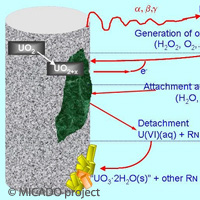Long-term EU-funded nuclear fission projects: the results are in!
Two major EU-funded nuclear waste-disposal projects have allowed researchers to reach a consensus on several key issues surrounding the chemical durability of both high-level waste glass and spent nuclear fuel. The two projects are GLAMOR ('Critical evaluation of the dissolution mechanisms of high level nuclear waste glasses in conditions of relevance for geological disposal') and MICADO (' Model uncertainty for the mechanism of dissolution of spent fuel in a nuclear waste repository '). They both set out to assess the uncertainties in several descriptive and predictive modelling procedures, and to describe the dissolution processes of nuclear waste glass containers and spent nuclear fuel in a repository over geological time periods. Both projects paved new paths in this research field by using a common set of existing experimental data and existing models. Geological disposal - isolation in deep geological formations - is today held as the safest long-term solution for dealing with long-lived nuclear waste. Worldwide, particular focus has been put on high-level radioactive waste resulting from spent nuclear fuel after discharge from nuclear power plants, as it constitutes more than 98 % of the radioactivity generated in these plants. This high-level radioactive waste can be in vitrified form for those countries with reprocessing options. Alternatively, the spent fuel itself can be considered as a form of waste. Potential disposal locations in Europe, in granite, clay or salt formations, are stable for tens of millions of years and are characterised by very slow groundwater movement. So far researchers have focused on building large experimental data bases to simulate the long-term interaction of groundwater with different types of nuclear waste glass and spent nuclear fuel. This includes glass with compositions similar to those produced in reprocessing and associated vitrification plants such as at La Hague in France or Sellafield in the United Kingdom. The GLAMOR project, carried out between 2002 and 2006, was funded with EUR 232,351 by the European Commission as part of the 'Nuclear energy' Thematic area of the Fifth Framework Programme (FP5) of the European Atomic Energy Community (Euratom). It saw scientists from Belgium and France come together to assess the principal hypotheses and uncertainties of models for the dissolution of nuclear waste glass in pure water systems without repository near-field materials, such as bentonite and metallic corrosion products. It was agreed that a residual dissolution rate exists for nuclear waste glass in pure water. This residual 'final' dissolution rate can be very important for the assessment of the barrier function and the lifetime of the glass, because it is as much as 10,000 times smaller than the initial dissolution rate. Lifetimes for vitrified high-level waste blocks of around 100,000 years and more can now be envisaged in such environments. The project scientists also found that the residual dissolution rate should be considered in the safety assessment calculations for a geological disposal site. The dissolution-rate decreasing stage that precedes the residual dissolution rate could be explained by several mechanisms included in the models. The model simulations did not allow for conclusions to be made about which mechanism was most dominant; however, the comparison did give a clear overview of the key problems that arise when interpreting the results, and highlighted several weaknesses in the underlying conceptual models. The subsequent MICADO project built on this groundwork made by the GLAMOR researchers. MICADO received EUR 1.3 million of funding from the European Commission as part of the 'Management of radioactive waste' Thematic area of the Sixth Framework Programme (FP6) of the Treaty of the European Atomic Energy Community (Euratom), and ran from 2007 to 2010. Scientists from Belgium, France, Germany, Spain, Sweden, Switzerland and the United Kingdom from European waste management agencies, technical organisations that support regulators, universities and research organisations assessed the current understanding of spent fuel behavior under disposal conditions. The team analysed current experimental knowledge, hydrogeological boundary conditions and current understanding of the physico-chemical processes controlling the release of radionuclide - an atom with an unstable nucleus - in order to identify the main points of uncertainty. Separate uncertainty analyses were carried out for the evolution of spent fuel: for the first few thousand years, when the container is still intact; and for the next few hundreds of thousands of years - a period that is likely to be characterised by hydrogen-saturated conditions with hydrogen arising from container corrosion for very long subsequent time periods, characterised by conditions where hydrogen concentrations have diminished but the ambient condition remains one of reduction. The team found that uncertainties on the surface area of spent fuel exposed to solutions - a very important factor when it comes to the calculation of the dissolution rate - could be strongly reduced. The assessment of large experimental datasets and of models for spent fuel matrix dissolution show that the UO2 matrix of spent fuel can serve as an effective isolation barrier for tens of thousands to millions of years. Few percent of the iodine and cesium inventories are however not bound in the UO2 matrix and these fractions can be released fast upon water contact. These fractions are lower than previously anticipated. Scientists now hope that the results from both projects will lead to significant further research in the field.For more information, please visit: European Nuclear Society: http://www.euronuclear.org/(opens in new window)
Countries
Belgium, Switzerland, Germany, Spain, France, Sweden, United Kingdom



